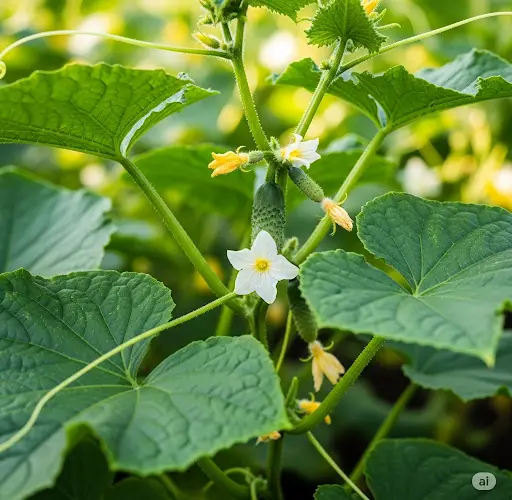Cucumbers are among the most rewarding crops to grow. They germinate quickly, climb readily, and can produce a heavy harvest even in small spaces. But like any plant, cucumbers are sensitive to poor growing conditions. If your cucumber plants are looking lifeless—yellowing leaves, wilting stems, stunted growth—it doesn’t mean they’re beyond saving.
In fact, there’s a surprisingly easy and natural method to revive even the most “dead-looking” cucumber vines. With just a little care and one powerful homemade treatment, your cucumbers can bounce back, grow rapidly, and resist diseases that commonly affect them during the season.
What Causes Cucumbers to Struggle?
Before treating sickly cucumber plants, it’s important to understand what went wrong. Several factors can cause cucumber vines to decline:
-
Nutrient deficiency: Cucumbers are heavy feeders and require a consistent supply of nitrogen, potassium, and phosphorus.
-
Poor soil structure: Compacted or exhausted soil limits root growth and nutrient absorption.
-
Overwatering or underwatering: Water imbalance stresses the plant and can lead to root rot or dehydration.
-
Pest or disease pressure: Aphids, powdery mildew, and bacterial wilt are common threats.
Fortunately, many of these problems can be addressed with a natural tonic made from materials you probably already have at home.
The Natural Cure: A Fermented Plant Tonic
To give sluggish cucumbers a boost, gardeners have long used a natural fermentation method that improves soil life, strengthens roots, and feeds the plant organically. The key ingredients? Weeds, water, and kitchen scraps.
This homemade fertilizer is rich in microelements, beneficial bacteria, and easily absorbed nutrients. It not only revives sick plants but also builds their resistance to pests and disease.
How to Make the Fermented Tonic
Here’s a simple recipe you can use to prepare a revitalizing liquid fertilizer for your cucumber plants:
Ingredients:
-
A handful of fresh weeds (nettle, dandelion, clover, or grass clippings work well)
-
1 banana peel (for potassium and phosphorus)
-
1 tablespoon of sugar or old jam (to speed fermentation)
-
Water (non-chlorinated, if possible)
Instructions:
-
Chop and Mix: Roughly chop the weeds and banana peel. Place them in a 2-liter container (a plastic bottle or bucket works fine).
-
Add Sugar: Add the sugar or jam. This acts as food for beneficial microbes.
-
Fill With Water: Pour in water until the container is about ¾ full. Leave some space for gases to escape during fermentation.
-
Cover Loosely: Cover with a cloth or loosely place a lid on top to allow airflow. Let the mixture sit in a warm place for 3–5 days, stirring once daily.
-
Strain and Use: Once it smells slightly sour and earthy (not rotten), strain the liquid. Dilute 1 part of this concentrate with 10 parts water before applying.
How to Apply It
Use the diluted tonic as a root drench—pour it gently around the base of each cucumber plant. Apply once a week during the active growing season. If your plants are severely stunted or yellow, apply it twice in the first week.
You’ll typically see improvements within days: leaves turn greener, growth resumes, and flowers begin to form. Even plants that looked nearly dead often begin putting out new shoots and climbing vigorously again.
Additional Tips to Support Recovery
While the tonic can do wonders, combining it with good gardening practices ensures long-term success:
-
Mulch: Add a layer of straw, dried grass, or shredded leaves to retain moisture and suppress weeds.
-
Support Vines: Use trellises or netting to keep cucumber vines off the ground, which improves airflow and reduces disease.
-
Water Deeply: Water at the base of the plant early in the morning, and avoid wetting the leaves to prevent fungal infections.
-
Remove Affected Leaves: Trim yellow or diseased leaves to help the plant focus its energy on healthy growth.
Prevent Future Problems
Once your cucumbers are back on track, continue applying the fermented tonic every 2–3 weeks to keep them strong and resilient. It’s a great preventive method, especially in organic gardens, where avoiding chemical fertilizers is a priority.
You can also rotate your tonic ingredients—add crushed eggshells for calcium, or used coffee grounds for nitrogen-rich boosts. The fermentation process breaks everything down into plant-available nutrients while enriching the microbial life in your soil.
Conclusion
Cucumbers are more resilient than they seem. Even if your plants are drooping, yellowed, or look hopeless, don’t pull them out just yet. With a little time, natural nourishment, and the right growing conditions, they can recover and thrive.
This fermented plant tonic is a simple, low-cost, and effective way to rejuvenate your garden. Try it out—and you might be surprised at how quickly those “dead” cucumbers leap back to life and reward you with a bumper crop.



